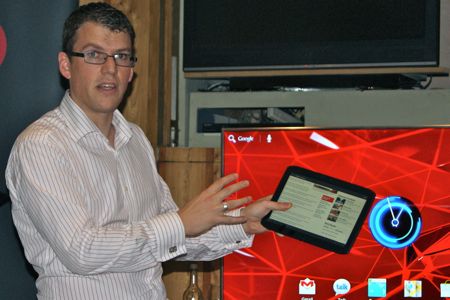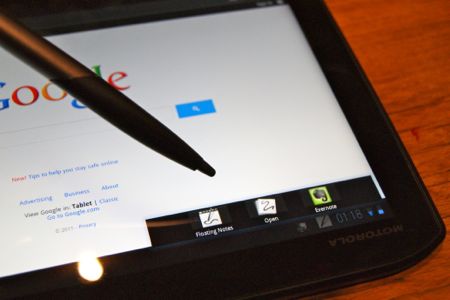Hands-on with the Motorola Xoom 2 and Xoom 2 Media Edition
Perhaps these will sell

If it's true that Motorola only managed to sell 100,000 of the original Xoom tablet, the company had two options. One was to give up, the other was to try again.
Considering Motorola helped Google launch the Honeycomb operating system, and is now owned by Google, it quite wisely opted for the second. In fact, it went one step further still by introducing two new tablets - the Xoom 2 and Xoom 2 Media Edition.
Xoom 2
The Xoom 2 has a 10.1-inch screen, with the same 1280x800-pixel resolution as the original Xoom, but it's now thinner (8.8mm) and about 100g lighter at 599g. It still runs on the Honeycomb operating system, but it'll be upgraded to Ice Cream Sandwich (Android 4) in early 2012.
Battery life is ten hours of usage between charges, while the dual-core processor is now clocked at 1.2GHz (with 1GB of RAM).

At launch, there will be just one version of the Xoom 2, with 16GB of integrated storage and wi-fi connectivity only. There's no memory card slot, either, as Motorola believes that the future will be in cloud-based services that can offer virtually limitless data storage.
Besides the changes to the physical appearance, there are some new hardware and software features.
From the RAZR comes the support for MotoCast, the service that allows you to access content from any PC or Mac connected to the net and running a small bit of client software, thus supporting Motorola's view that having loads of on-board storage is unnecessary. Fine if you have a PC and Mac brimming with content.
There's also 'Splashguard' protection that protects the tablet from splashes of liquid, thanks to a special coating on the casing and innards. The screen itself is constructed with Corning Gorilla Glass to resist scratches.

Firm grip
Another cool feature is 'Intelligent Grip Suppression'. Given how often your thumb can come into contact with the screen when gripping with one hand, it's a very useful feature that begs the question: why didn't anyone think of it before?
Instead of trying to hold your tablet carefully at the edge, you can quite brazenly put your thumb anywhere at the edge and continue to use it with another hand to scroll, pinch-to-zoom or use other gestures. The thumb is totally ignored, which means there's far less chance of the tablet falling out of your hand.
Good news for anyone who uses a tablet while lying in bed and has had it fall on his face.

Taking (remote) control
A feature Motorola made little fuss about was the infrared port, which works with a pre-loaded app called Dijit. Put simply, it allows you to operate your TV, set top box, or Blu-ray player from your tablet. If you've seen how much fancy programmable remotes can cost, you could almost consider the Xoom 2 to be a bargain.
Don't write it off until you try it
The last new feature is support for the optional accessory, the Motorola Stylus with Precision tip, which allows you make annotations on documents and photographs, or simply scribble out notes.
When the stylus is enabled, you're given shortcuts to some note-taking applications, such as Evernote, at the bottom-right hand corner of the screen.



Motorola couldn't give a price for the stylus, but it will be part of a range of accessories that includes a dock, as well as support for the recently announced Smart Controller – a Bluetooth remote control that also doubles up as a Bluetooth handset to talk into. Without 3G, you're limited to using services like Google Chat or Skype.
I can't stress enough how much I think a camera is pointless on a tablet (try taking a photo or recording a video and you'll see why) but Motorola would undoubtedly be criticised if it didn't include one, so it has put in a 5-megapixel autofocus camera on the rear (with LED flash) and a 1.3-megapixel one on the front for video chat.
The Xoom 2 will be on sale in mid-November from Carphone Warehouse, with a retail price of £379.99. The prototype model we got a look at still had ports that suggest a 3G-enabled version could be a possibility in the future, if sales go a little better than the first time around.
Motorola Xoom 2 - Key features- 253.9 x 173.6 x 8.8mm / 599g
- 10.1-inch HD display, 1280x800 pixels
- 5-megapixel AF camera with LED flash (rear)
- 1.3-megapixel camera (front)
- 1.2GHz dual-core processor
- Android 3.2 (Honeycomb) with update to Android 4 in 2012
- 10 hours (web) usage
- 16GB fixed storage
- Wi-Fi connectivity
- Infrared port & DLNA support
- Support for Motorola Stylus
- 3D Virtual surround sound
Xoom 2 Media Edition
The second new tablet is the Xoom 2 Media Edition, which has a smaller 8.2-inch display but is essentially the same design. It has the same processor, operating system, RAM, and cameras. However, with the smaller size comes a smaller battery, offering only six hours of usage between charges.

Designed with media in mind, the screen has been optimised for video playback, as well as being used in portrait mode for viewing digital newspapers, books, and magazines – an attempt to pitch this model against the new Amazon Kindle Fire.
There's also an adaptive virtual surround system that works through multiple integrated speakers, along with 'booming bass'. Sadly, this was something I couldn't test on the day to see if such bold claims were warranted.
The Xoom 2 doesn't come with support for the digital stylus, but you can still use apps like Skitch (an add-on for Evernote) to draw notes and annotations with your finger.
Other than that, the Xoom 2 Media Edition is pretty much the same as the Xoom 2, but a tad more portable and cheaper at £329.99. It will also come with an update to Ice Cream Sandwich in 2012.
Motorola Xoom 2 Media Edition - Key features- 216 x 139 x 8.99mm / 386g
- 8.2-inch HD display, 1280x800 pixels
- 5-megapixel AF camera with LED flash (rear)
- 1.3-megapixel camera (front)
- 1.2GHz dual-core processor
- Android 3.2 (Honeycomb) with update to Android 4 in 2012
- 6 hours (web) usage
- 16GB fixed storage
- Wi-Fi connectivity
- Infrared port & DLNA support
- Adaptive virtual surround sound with booming bass
